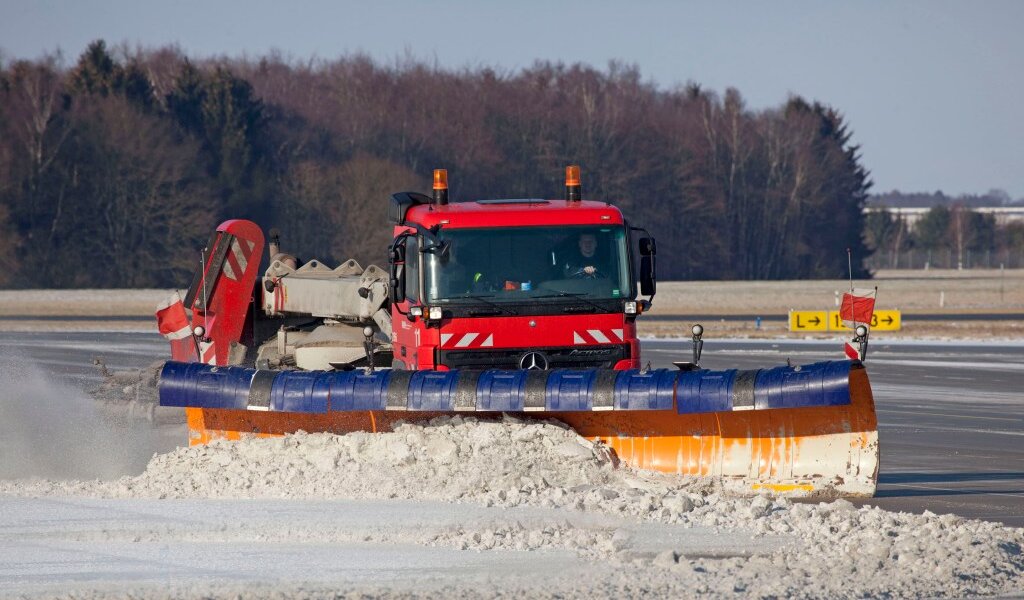No matter what the weather is like on the day, every year 1 November heralds the start of winter at Hamburg Airport. “We are of course prepared for the eventuality that snow and frost may occur earlier than this,” says Michael Rumstedt, Head of Traffic Control at Hamburg Airport and also the winter surface compliance officer for the last five years.
“But experience tells us that this date is about right.” The general rule is that, if there is any more than 0.2 centimetres of slush on the ground, the runways need to be cleared immediately. “Winter surface clearance always demands a maximum level of understanding and flexibility from the employees – the weather does not ‘conform’ to a schedule,” stresses Michael Rumstedt.
30 employees from the Hamburg Airport Group work in four shift groups and are on standby to clear snow and remove ice around the clock. They are also assisted by workers from various companies from Hamburg, Schleswig-Holstein and Lower Saxony. 25 employees are required just to clear the aircraft movement areas on each day and night shift because the runways need to be cleared if there is any more than 0.2 cm of slush. Then there are also the 481,000 m2 of apron as well as 25 kilometres of service and supply roads, walkways and parking areas. “This painstaking work is required to guarantee the safety of our passengers,” says Michael Rumstedt, who is responsible for overall coordination of the deployment of equipment, materials and personnel and for liaising with all the relevant areas at the airport.
Infrastructure and fleet also designed to cope with a harsh winter
Hamburg Airport has expanded its winter maintenance capability in recent years: a new tank storage facility can hold around 350,000 litres of de-icing agent for de-icing surface areas – more than ever before in Hamburg. A specially adapted VW Sharan from Traffic Control, the “Friction Tester”, determines whether runways need to be cleared of snow and ice because a fifth wheel allows it to measure the ground traction on the runways. The snow and ice clearance fleet is also very well equipped: around 45 special vehicles are deployed to carry out winter maintenance at Hamburg Airport. “We ensure that flights can operate safely in winter with nine snow clearance vehicles, consisting of a truck with a snow plough and sweeper-blower, two mid-axle sweepers, two tractors with brushes for apron positions, two snow-cutters, three wet sand spreaders and two de-icing sprayers with a 36-metre-long spraying bar,” explains Nils Petersen, head of snow and ice operations. Hamburg Airport also has the right equipment to get to corners that are difficult to access: two Unimogs with a brush/spreader.
Safety and protection of the environment on the runway
The huge amounts of snow at Hamburg Airport are cleared by mechanical means and thus in an environmentally friendly way. 90 to 95 per cent of the snow is removed by clearance vehicles and snow-cutters. Not least the Schmidt snow ploughs, which are up to 8 metres wide, are responsible for this task. The airport also does not use any gritting salt. It would attack the various materials used on the aircraft and get into the groundwater, thus silting up the soil and damaging plant life. This is why an environmentally compatible and effective mixture of solid and liquid potassium formate is used to clear the remaining 5 to 10 per cent of the snow. An aqueous solution containing 50 to 80 per cent potassium formate is applied here with the aid of solid potassium formate (granules).
The snow and ice clearance service is deployed 24/7
Depending on how severe the snowfall is, up to eight clearance vehicles, one snow-cutter and two wet sand spreaders are deployed on the runways simultaneously to shift the snow from the runways onto the surrounding land. What is more, two vehicles from Traffic Control must constantly monitor and coordinate the results of the clearance work. In heavy snowfall, it takes around 30 minutes to clear a runway and this process must be repeated eight to ten times a day in particularly inclement weather conditions. This ensures that air traffic can operate smoothly at Hamburg Airport around the clock whenever there is any snow or frost. Applicable restrictions on night flights are not observed here because vital rescue missions need to be possible at any time.
